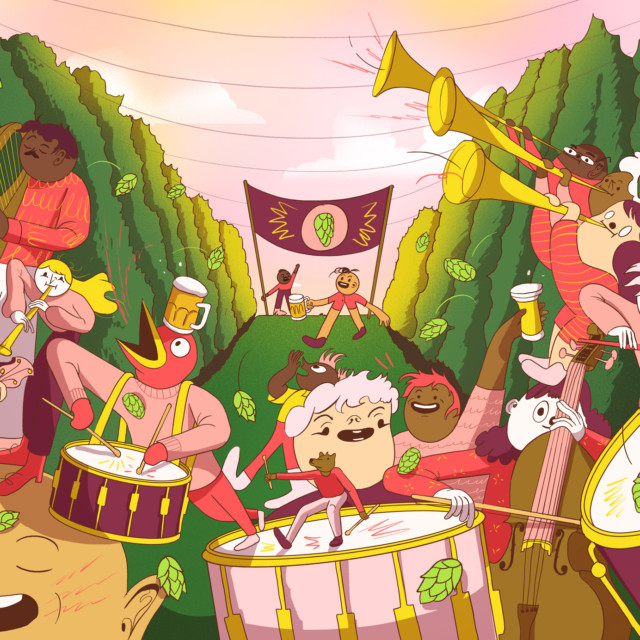From raising a liter of lager in a Bavarian beer garden to sipping a chalice of Trappist ale at a monastic brewery, or knocking back a pint of bitter in an English pub, there are a few quintessential accomplishments every dedicated beer fan hopes to check off their bucket list.
With more farm breweries scattered across the United States and the appreciation for hops increasing by the year, there’s another experience to seek out: drinking in a hop field. And late summer — at the start of the harvest — is the time to do it, because by the end of September, the greenery will be gone. Ranging from full-fledged farms to small-scale plots, a number of breweries around the country (and Canada, too) grow their own hops, with a few even encouraging participation at harvest time. You don’t have to help, of course, but it’s a novel way to boost your beer geek cred.
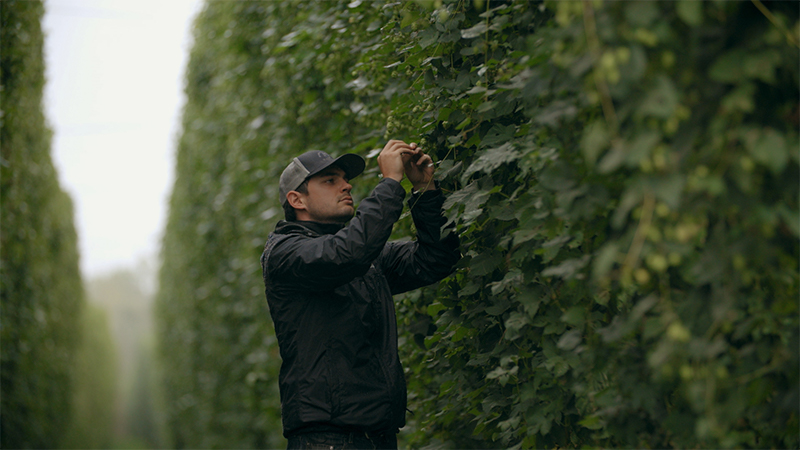
Out West on one of the country’s largest and oldest hop farms there’s Bale Breaker Brewery, bordered on three sides by these aromatic perennials. Not to be outdone, Oregon’s Crosby Hop Farm has even added a seasonal beer garden (at the end of Lupulin Lane, no less), where visitors can taste beers made with a wide range of varieties grown right there in the Willamette Valley.
Meanwhile, back east, from The Brewery at Four Star Farms in Massachusetts to Maryland’s Milkhouse Brewery, numerous states now have places where beer geeks can lounge in the shade and watch their favorite plants reach for the sky.
“When we decided to build a brewery at the farm we could think of no better place to put it than where our original small experimental hop yard once stood, which is also the confluence of our two large hop yards,” says Liz L’Etoile, co-owner and marketing director at The Brewery at Four Star Farms, which opened to sell beer to go in December 2020. Taking a conservative approach at first, Four Star Farms eventually expanded to four acres of hops, then seven, and now 17, which include nine different varieties that run the gamut from the familiar (Cascade, Centennial) to the obscure (Chaos and TeaMaker).
Every beer that flows through the taps here is made exclusively with estate-grown hops. Whether you prefer the light, crisp Northfielder Pilsner or the bold and bright Solstice double IPA, you can be sure you’re tasting the terroir of the Pioneer Valley. Plus, as Four Star approaches its first harvest since adding a brewery, visitors will be able to tour the hop yards with beer in hand.
“No matter where you look while visiting the brewery, you see where we grow the ingredients for our beer and the landscapes that surround us,” L’Etoile says. “From inside the brewery, you almost feel as though you’re outside due to the large windows that overlook the yards; and the interior is warmly ornamented with four species of wood that we harvested from the farm to truly make it ‘of this place.’”
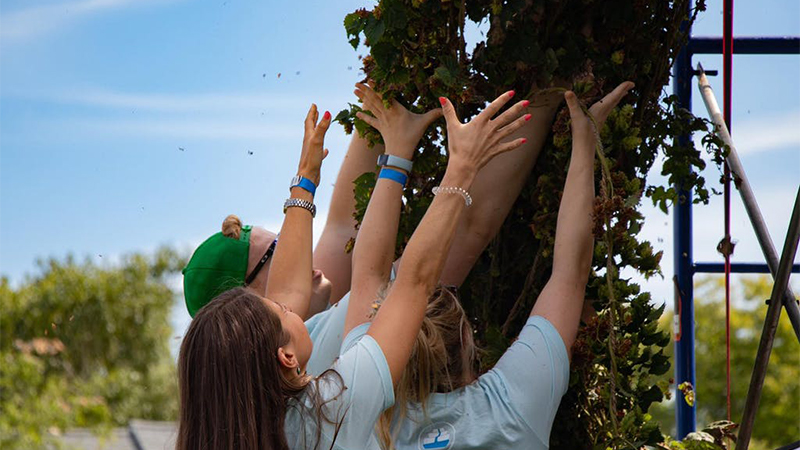
About two hours from Manhattan, on 50 acres of land in Connecticut, Kent Falls Brewing grows two varieties for its annual fresh hop farmhouse ale.
With only about a third of an acre devoted to the eye-catching climbing bines, Kent Falls doesn’t have nearly enough plants to make everything with homegrown hops. Nonetheless, the 80 to 100 pounds of fresh cones it does harvest each year end up in a mixed fermentation table beer that first appeared in 2015. Initially called Tiny House, this annual release now known as Campland is brewed with Chinook and Brewer’s Gold hops and ends up around 4 percent alcohol by volume (ABV).
“Brewer’s Gold is an old school, floral, noble-y hop, and Chinook gives you that citrusy, piney push,” says Barry Labendz, Kent Falls co-founder and general manager. “I love the profile it produces, which is slightly different every year. We also get a lot of the preservative qualities of 90 pounds of hops,” he adds.
From the beginning, the fresh hop brew day has been accompanied by a community pig roast with live music and the opportunity to help pick resinous cones from the long, twisting bines once they’re cut from their supporting poles in the hopyard. Tickets ($65/$35) include food, four beers or non-alcoholic beverages, and a souvenir glass, but are limited to 125 people and typically sell out quickly. With the Covid-19 pandemic putting last year’s event on ice, this September’s hop harvest is sure to bring fans back to the Kent Falls Camps Road Farm. Fortunately for those who miss it, or won’t be able to time a visit with the harvest, Kent Falls offers free, kid-friendly farm tours every Saturday throughout the summer.
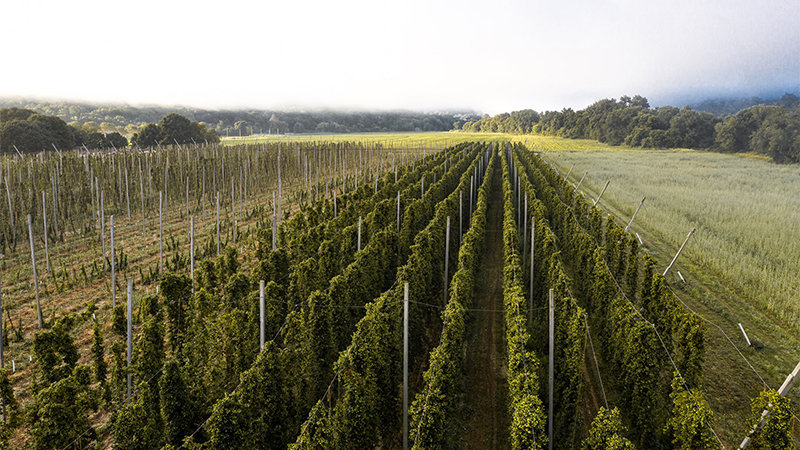
Far to the north, on the other side of the U.S. border, Canada’s Big Spruce Brewing grows eight varieties of hops on about a quarter of an acre of its scenic property on Cape Breton Island. According to co-founder Melanie Bock-White, the plants have “taken beautifully” to the temperamental climate of the Maritime provinces, and last year yielded about 250 pounds of bitter beauties.
Like Kent Falls, Big Spruce doesn’t try to produce all of its beer with hops grown on site. The family business brews two beers with the local bounty: an annual fresh hop ale and a “Cape Breton wild ale” called One Hundred that also includes Nova Scotian malt and a native yeast collected and propagated from one of the farm’s cherry trees.
“The ingredients in beer can be confusing, but seeing them grown with your own eyes and [understanding] how they get transformed into this amazing liquid is truly a happy education for people,” Bock-White says, adding that the hop harvest usually begins in late August and lasts about five days.
Beer tourists are encouraged to take part in the harvest, even if wandering through the hopyard sounds better than plucking cones all afternoon, Bock-White says. “Hop harvest is always such a celebration, and such a great way to teach folks about the brewing process. It all makes sense when you can touch, taste, and smell these incredible ingredients. The beer is so fresh, the days are always warm and sunny, and people are helping to bring new beer to life. What’s not to love?”
Back down the Eastern Seaboard in Maryland, Tom Barse and Carolann McConaughy have farmed 47 acres of land in Mount Airy since 2008. Five years later, after helping to persuade lawmakers to approve a new type of brewing license, they opened Milkhouse, the state’s first farm brewery. Starting with Cascade and Chinook hops, which they sold to other breweries in the area, the couple has since added Southern Cross and a new wild variety found in Frederick County to their one-acre hopyard. German farmers planted the first hop fields here in the mid-19th century, and Barse is proud to continue that legacy, supplementing what he can harvest with hops and malt from elsewhere in the state.
“We are close to several old hop farms from the 1800s that used to provide hops to Maryland breweries many years ago,” says Barse. “Maryland brewers are very interested in using local ingredients in their beers, and we work closely together with them.”
Barse and his two brewers also make good use of the hops themselves, relying on their own Cascades in Stairway IPA and both Chinook and Southern Cross (as well as Brewer’s Gold from another local grower) in Green Farmer Pale Ale. As is typical with many breweries that have planted hops, Milkhouse brews a pale ale with fresh hops every year, too.
“This year has been a great growing season,” Barse says. “We are really looking forward to our wet-hop brew in August. [But] one sip of any of our beers will show you how great local ingredients can be.”
North of Sacramento, Calif., in the foothills of the Sierra Nevada Mountains, Michael and Catherine Johnson make farm- to-tap beer in a converted red barn surrounded by orchards, gardens, and two acres of hops including Mt Hood, Perle, Crystal, Fuggle, Liberty, Zeus, Willamette, Newport, Tettnang, and Saaz. And here at GoatHouse Brewing, 99 percent of what’s pouring in the tasting room is made with one or more of the varieties growing just outside. The only hops the Johnsons use that they don’t grow are a handful of patent-protected varieties.
With so many types of hops in the ground, Catherine Johnson mentions that the picking window can sometimes stretch into October. But after an unexpectedly large harvest in year one, she says they “knew [they] were onto something great.”
Named the country’s second-fastest-growing brewery back in 2018, GoatHouse is a dependable place to find a wide variety of beer styles, whether you’re a fan of English-style Mild Ale, Belgian-style Strong Ale, or West Coast IPA. And yes, you can pet the goats that help weed and fertilize the fields.
“As owners and operators, we are always around to talk with customers, host classes with continuing education [programs], lead farm tours, and just [have] casual conversations, sharing our learning and experience to date,” Johnson says. “Our take is that farming is both art and science, and it’s a continuously evolving, hands-on learning environment trying to grow and brew the best products possible.”
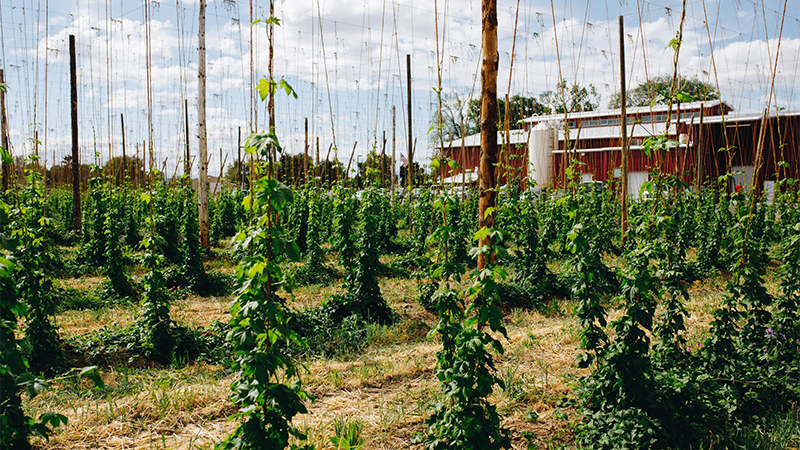
In the Pacific Northwest, Bale Breaker kegs and cans its popular beers from the heart of hop country: the Yakima Valley. And this family-owned business, which has quickly become the fourth-largest brewing company in Washington, can trace its agricultural roots all the way to 1932 when B.T. and Leota Loftus, great-grandparents of the company’s founders, established a hop farm that now covers approximately 2,400 acres and produces upwards of 6 million pounds of hops every year. Loftus Ranches operates separately from Bale Breaker, but hop field No. 41 bumps right up against the brewery’s property and lends its name to the flagship pale ale, reinforcing the connection.
“We grew up here, and our family’s legacy is here — we always say that hops are in our DNA,” says co-owner and business manager Meghann Quinn. “It’s been pretty amazing to continue what our great-grandparents started, and to watch the next generation of Smiths run around on these hop farms and know that they might take over. It’s also been particularly meaningful to take what the generations before us started and take it a step further. In the past few years, we’ve expanded into growing our own barley and brewing 100 percent homegrown beers.”
Bale Breaker’s taproom is open six days a week, and includes ample seating indoors and out. Expect food trucks slinging tacos or burgers, some of the freshest IPAs you’ve probably ever tasted, and, come harvest time, quite a few sights, sounds, and smells you’re unlikely to find anywhere else.
“Visiting the Yakima Valley, especially during harvest, drives home exactly what we mean when we say ‘fresh off the farm,’” Quinn says. “In September, the air all around the valley smells like hops, and it’s not unusual to drive from town to the brewery alongside a handful of hop trucks. A lot of people theoretically know what goes into their beer, but seeing the acres upon acres of fields of hops really emphasizes how much work goes into every pint.”
Editor’s note: On July 29, Florencio Gueta Vargas, a farmer at Virgil Gamache Farms in Yakima County, Wash., died while working due to heat-related causes. His eldest daughter Lorena Gonzalez Cortez has created a GoFundMe page in his honor to help the family with funeral costs and other expenses.
According to the Washington State Department of Health, a total of 112 heat-related deaths were reported in 20 counties during the 2021 heat wave, making it the deadliest in the state’s history. Washington Department of Health hot weather safety resources are available here.
